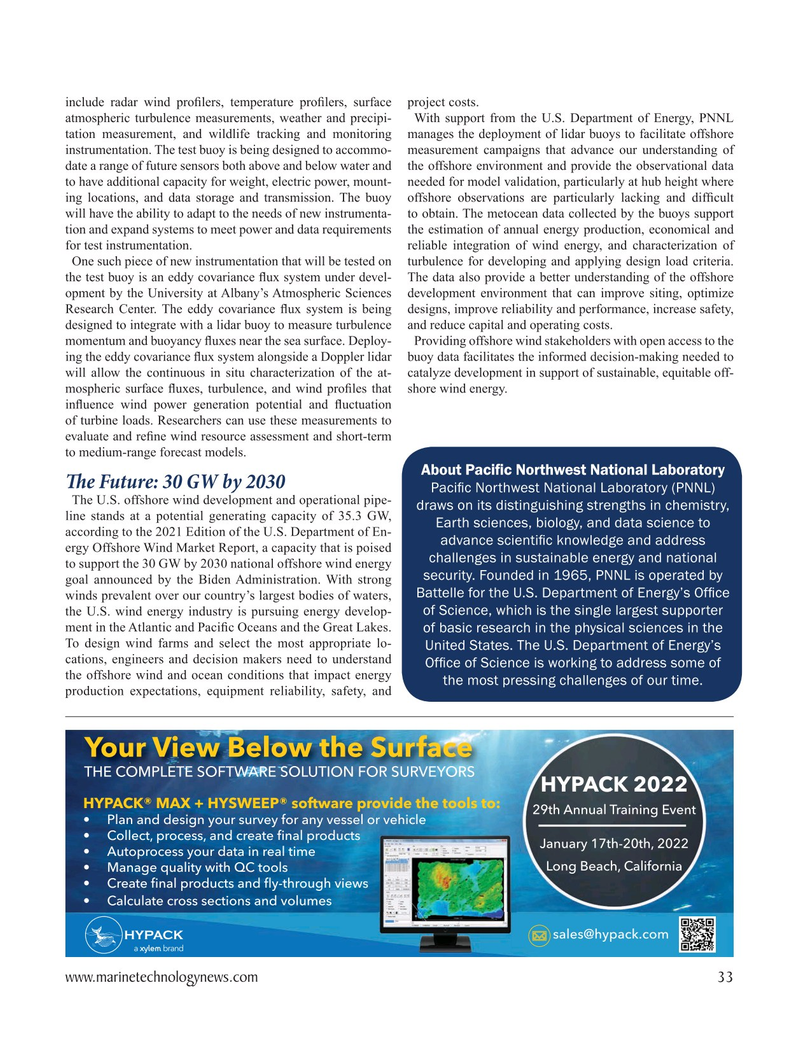
Page 33: of Marine Technology Magazine (November 2021)
Ocean Observation: Gliders, Buoys & Sub-Surface Networks
Read this page in Pdf, Flash or Html5 edition of November 2021 Marine Technology Magazine
include radar wind pro? lers, temperature pro? lers, surface project costs.
atmospheric turbulence measurements, weather and precipi- With support from the U.S. Department of Energy, PNNL tation measurement, and wildlife tracking and monitoring manages the deployment of lidar buoys to facilitate offshore instrumentation. The test buoy is being designed to accommo- measurement campaigns that advance our understanding of date a range of future sensors both above and below water and the offshore environment and provide the observational data to have additional capacity for weight, electric power, mount- needed for model validation, particularly at hub height where ing locations, and data storage and transmission. The buoy offshore observations are particularly lacking and dif? cult will have the ability to adapt to the needs of new instrumenta- to obtain. The metocean data collected by the buoys support tion and expand systems to meet power and data requirements the estimation of annual energy production, economical and for test instrumentation. reliable integration of wind energy, and characterization of
One such piece of new instrumentation that will be tested on turbulence for developing and applying design load criteria. the test buoy is an eddy covariance ? ux system under devel- The data also provide a better understanding of the offshore opment by the University at Albany’s Atmospheric Sciences development environment that can improve siting, optimize
Research Center. The eddy covariance ? ux system is being designs, improve reliability and performance, increase safety, designed to integrate with a lidar buoy to measure turbulence and reduce capital and operating costs.
momentum and buoyancy ? uxes near the sea surface. Deploy- Providing offshore wind stakeholders with open access to the ing the eddy covariance ? ux system alongside a Doppler lidar buoy data facilitates the informed decision-making needed to will allow the continuous in situ characterization of the at- catalyze development in support of sustainable, equitable off- mospheric surface ? uxes, turbulence, and wind pro? les that shore wind energy.
in? uence wind power generation potential and ? uctuation of turbine loads. Researchers can use these measurements to evaluate and re? ne wind resource assessment and short-term to medium-range forecast models.
About Paci? c Northwest National Laboratory
T e Future: 30 GW by 2030
Paci? c Northwest National Laboratory (PNNL)
The U.S. offshore wind development and operational pipe- draws on its distinguishing strengths in chemistry, line stands at a potential generating capacity of 35.3 GW,
Earth sciences, biology, and data science to according to the 2021 Edition of the U.S. Department of En- advance scienti? c knowledge and address ergy Offshore Wind Market Report, a capacity that is poised challenges in sustainable energy and national to support the 30 GW by 2030 national offshore wind energy security. Founded in 1965, PNNL is operated by goal announced by the Biden Administration. With strong
Battelle for the U.S. Department of Energy’s Of? ce winds prevalent over our country’s largest bodies of waters, of Science, which is the single largest supporter the U.S. wind energy industry is pursuing energy develop- ment in the Atlantic and Paci? c Oceans and the Great Lakes. of basic research in the physical sciences in the
To design wind farms and select the most appropriate lo-
United States. The U.S. Department of Energy’s cations, engineers and decision makers need to understand
Of? ce of Science is working to address some of the offshore wind and ocean conditions that impact energy the most pressing challenges of our time.
production expectations, equipment reliability, safety, and
Your View Below the Surface
THE COMPLETE SOFTWARE SOLUTION FOR SURVEYORSTHE COMPLETE SOFTWARE SOLUTION FOR SURVEYO ORS
HYPACK 2022
HYPACK® MAX + HYSWEEP® software provide the tools to: 29th Annual Training Event •Plan and design your survey for any vessel or vehicle •Collect, process, and create ?nal products
January 17th-20th, 2022 •Autoprocess your data in real time •Manage quality with QC tools Long Beach, California •Create ?nal products and ?y-through views •Calculate cross sections and volumes [email protected] www.marinetechnologynews.com 33
MTR #8 (18-33).indd 33 11/22/2021 12:42:15 PM

 32
32

 34
34
